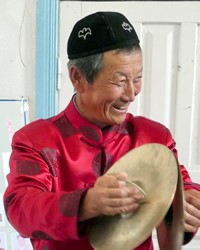The Dungan originated in the Kansu and Shensi provinces of northwestern China. The Dungan arrived in Central Asia with almost nothing after their loss to the Chinese Emperor in the Dungan Revolt (1862-1877).
Russians refer to the Dungan as Dugane. Culturally, the Dungan are Chinese; Arabic, Persian and Turkish have all influenced their language. Many Dungan speak the Kazakh language besides their own, and the young people also speak Russian. Their language, Dungani, is Mandarin Chinese but uses the Cyrillic script. It has only three tones instead of four.
The Dungan have a mixture of Chinese, Muslim, and Russian cultures. They are a proud, hospitable, nationalistic, and conservative people. Although they have completely cut their ties to China, they refer to themselves as Hui-Zu, or "Chinese Muslims."They are closely associated with China's Hui people. Most of them live in Kyrgyzstan and Kazakhstan, but there are also smaller populations in Russia, Uzbekistan, and Mongolia.
The Dungan are primarily farmers, growing rice and vegetables such as sugar beets. Many also raise dairy cattle. Some grow opium. They are mostly a rural people. Very few live in the cities. Those that do have found jobs as writers, linguists, historians, poets, and newspaper editors.
The Dungan are considered more wealthy than neighboring ethnic groups, as they have plenty of meat and vegetables. They enjoy meals of fried vegetables, lamb, chicken, and oriental noodles, all lavishly seasoned with garlic and vinegar. Most eat with chopsticks like their ancestors did in China.
They love to keep flower gardens and greenhouses and take great pride in doing so. Their settlements are concentrated in river valleys. A Dungan farm village may have a population of thousands. Each village has a council that manages the farm. Farms, which are basically small cities, have electricity, running water and gas for cooking. In each farm village, there are one or two schools. Each village has day nurseries, general stores, a hospital, and a post office. Some also have tobacco factories, evening schools, dairies, bathhouses, and machine repair shops.
The Dungan tend to be endogamous, meaning they marry within a certain specified group. The Dungan in Kazakhstan are more conservative than those in Kyrgyzstan and do not permit their girls to marry Dungan from any other place. The Dungan believe in having as many children as possible. It is easy for the Dungan to travel because they have relatives in many villages.
The Dungan are famous for their hospitality and hold many ceremonies and banquets to preserve their former culture. They have elaborate and colorful observances of birthdays, weddings and funerals. Schools often have museums to preserve other parts of their culture, such as embroidery, traditional clothing, silver jewelry, paper cuts of animals and flowers, and tools the Dungan used many years ago.
A mixture of Chinese, Muslim and Russian cultures blend together to create the unique Dugan culture.
They are virtually all Hanafite, one of the conservative schools of Sunni Islam. The older people strictly observe Islamic law. The younger Dungan are indifferent to Islam, not turning to religion until the age of 40. There are still village mosques run by elders. The Dungan in Kazakhstan are more committed to Islam than are those in Kyrgyzstan.
The Dungan have had little opportunity to hear the gospel. They remain nominally Muslim. The only known Dungan believers are in Kyrgyzstan. There is a need for believers to teach the word of God as well as to begin a church planting movement among the Dungan.
Pray that God will send culturally sensitive believers who will show the Dungan people the way to the cross.
Pray for a Christ-ward movement to flourish among this people group in the 2020s.
Pray for the Dungan people to be blessed with peace, joy and spiritual prosperity as they follow Jesus Christ.
Pray for Dungan leaders to have dreams and visions that will open their hearts to Jesus Christ and his ambassadors.
Scripture Prayers for the Dungan in Kazakhstan.
| Profile Source: Joshua Project |












